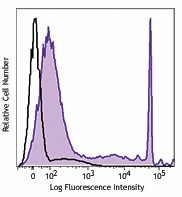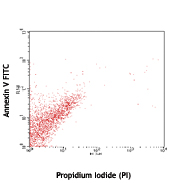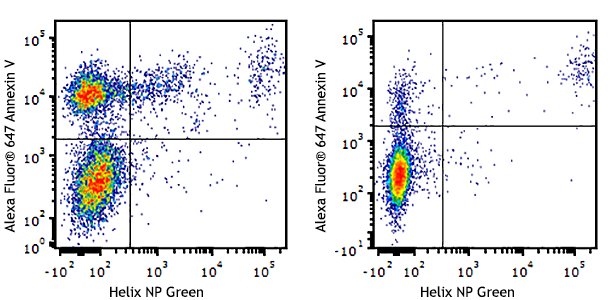- Regulatory Status
- RUO
- Ave. Rating
- Submit a Review
- Product Citations
- publications

-

One day old C57BL/6 mouse splenocytes were stained with Helix NP™ NIR (filled histogram). Cells alone, without Helix NP™ NIR staining, are also shown (open histogram). -

Mouse frozen cerebellum tissue was fixed with 4% paraformaldehyde (PFA) for ten minutes, permeabilized with 0.5% Triton X-100 for ten minutes, and blocked with 5% FBS for one hour. Then the tissue was intracellularly stained with 5 µM of Helix NP™ NIR (red) for fifteen minutes at room temperature and co-stained with Flash Phalloidin™ Green (blue). The image was captured with 10X objective. -

HeLa cells were fixed with 1% paraformaldehyde (PFA) for ten minutes, permeabilized with 0.5% Triton X-100 for ten minutes, and blocked with 5% FBS for 30 minutes. Then the cells were intracellularly stained with 5 µg/mL of Alexa Fluor® 488 anti-Cytokeratin (pan reactive)(green) antibody in blocking buffer overnight followed by 10 µM of Helix NP™ NIR (red) for fifteen minutes at room temperature. The image was captured with 60X objective.
| Cat # | Size | Price | Quantity Check Availability | Save | ||
|---|---|---|---|---|---|---|
| 425301 | 1 mL | 212€ | ||||
Helix NP™ NIR is a far-red emitting nucleic acid stain. It is impermeant to live cells and thus can be used for the discrimination of live and dead cells. In immunofluorescence microscopy, it can be used as a nuclear counterstain in cells and tissue. It is optimally excited at 640 nm with an emission at 660 nm, which can be detected in the Alexa Fluor® 647 or APC channel.
Product DetailsProduct Details
- Preparation
- Helix NP™ NIR is supplied at 1ml per vial.
- Concentration
- 1.0 mM
- Storage & Handling
- Upon receipt, store at -20°C. For the best long term usage, aliquot the reagent and store at -20°C.
- Application
-
FC - Quality tested
IHC-F, ICC - Verified - Recommended Usage
-
For use in viability assays, the optimal concentration can range from 5 μM- 50 μM. For immunocytochemistry and immunohistochemical staining on frozen tissue sections, the suggested use of this reagent is 0.5 μM -5 μM. It is recommended that the reagent be titrated for optimal performance for each application.
- Application Notes
-
Helix NP™ NIR is a cell-impermeant nucleic acid probe suitable for use as a viability dye in flow cytometry. It can also be used for viability in microscopy on live cells or as a nuclear counterstain on fixed and permeabilized cells and tissues. It is a far-red emitting dye with an excitation/emission max of 640 nm/660 nm that can be detected in the Alexa Fluor® 647 or APC channel.
Protocol for viability staining using Helix NP™ NIR:
1. Isolate cells following protocol of choice.
2. Dilute Helix NP™ NIR to required concentration. We recommend titrating the reagent to determine optimal concentration for cells of interest. We have observed good results in flow cytometry at 5 μM- 50 μM.
3. Following the addition of Helix NP™ NIR to cells, do not wash, cells are ready for acquisition.
4. Analyze cells on a cytometer equipped with the 633 red laser.Protocol for nuclear counterstaining fixed and permeabilized cell specimens using Helix NP™ NIR:
1.Fix cultured cells with 1%-4% Paraformaldehyde (PFA) for 10 minutes at room temperature.
2. Wash the cells two times with 1X PBS.
3. Permeabilize the cells with 0.5% Triton X-100 for 10 minutes at room temperature.
4. Wash the cells two times with 1X PBS.
5. Block cells with 5% fetal bovine serum for 30 minutes at room temperature.
6. Prepare the working solution.
a. We recommend titrating the reagent to determine optimal concentration for cells of interest. We have observed good results in the 0.5 µM -5 µM range for IHC-F and IF/ICC
7. Stain the cells with diluted solution for 20 minutes at 4°C or room temperature in dark.
a. Make sure to protect from light when staining and prior to imaging.
8. Perform a quick wash of the cells with 1X PBS twice.
9. Incubate cells with 1X PBS for 10 minutes in 4°C in dark.
10. Mount the slides with a media and image the slides. - Product Citations
-
Antigen Details
- Biology Area
- Apoptosis/Tumor Suppressors/Cell Death, Cell Biology, Cell Cycle/DNA Replication, Cell Proliferation and Viability
- Gene ID
- NA
 Login / Register
Login / Register 















Follow Us